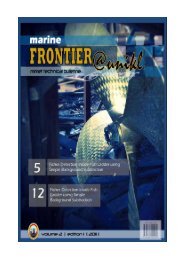click here to download - UniKL MIMET Official Website
click here to download - UniKL MIMET Official Website
click here to download - UniKL MIMET Official Website
You also want an ePaper? Increase the reach of your titles
YUMPU automatically turns print PDFs into web optimized ePapers that Google loves.
Figure 6: Enclosed life boat with self contained air support<br />
system<br />
For safety of navigation, installation of<br />
radio communication equipment is important.<br />
At least three (3) two‐way VHF radiotelephone<br />
apparatus shall be provided on every cargo ship<br />
of 500 gross <strong>to</strong>nnage and upwards. Furthermore,<br />
ships also need <strong>to</strong> be fitted with a Global Mari‐<br />
time Distress and Safety System (GMDSS) for the<br />
purpose of providing a maritime mobile service<br />
identity. In this case, INMARSAT identity and<br />
ship’s serial number may be transmitted by the<br />
ship’s equipment and used <strong>to</strong> identify the ship in<br />
emergency situation (SOLAS Regulation 2).<br />
Figure 7: Layout cargo pump‐room with carbon dioxide fire‐<br />
extinguishing system<br />
<strong>MIMET</strong> Technical Bulletin Volume 1 (2) 2010<br />
A chemical tanker is a vessel that has high<br />
risk of explosion. Chemical tanker Kemal Ka suffered<br />
explosion on board on 13 th June 2010, 13 nautical<br />
miles off Almedina, near Chipiona and on 29 th Feb‐<br />
ruary 2004, a chemical tanker The Bow Mariner<br />
sinks after an explosion off the coast of Virginia. As<br />
a result, under SOLAS Chapter II‐2 Regulation 7, fire<br />
detection and alarm system must be installed in the<br />
tanker especially at places periodically unattended<br />
such as machinery spaces, the main propulsion and<br />
associated machinery. Smoke detec<strong>to</strong>r should be<br />
fitted at all stairways, corridors and escape routes.<br />
Under regulation 10, ships constructed on or after<br />
1 st July 2002, are required <strong>to</strong> be fitted with suitable<br />
fire fighting systems that can be operated from a<br />
readily accessible position outside the pump‐room.<br />
Cargo pump‐rooms shall be provided with a system<br />
suitable for machinery spaces for ships in category<br />
A. In this case, a carbon dioxide (CO2) fire‐<br />
extinguishing system complying with the provisions<br />
of the Fire Safety Systems Code, such as the alarms<br />
giving audible warning of the release of fire extin‐<br />
guishing medium shall be safe for use in a flamma‐<br />
ble cargo vapour/air mixture. A notice shall be ex‐<br />
hibited at the controls stating that, due <strong>to</strong> the elec‐<br />
trostatic ignition hazard, the system is <strong>to</strong> be used<br />
only for fire extinguishing and not for inerting pur‐<br />
poses. The extin‐<br />
guishing method of<br />
CO2 gas is based on<br />
the reduction of the<br />
oxygen level in air <strong>to</strong><br />
a certain level of CO2<br />
concentration. Com‐<br />
bustion cannot be<br />
sustained in an at‐<br />
mosp<strong>here</strong> containing<br />
a minimum of 34% of<br />
CO2.<br />
| MARINE FRONTIER @ <strong>UniKL</strong><br />
117



